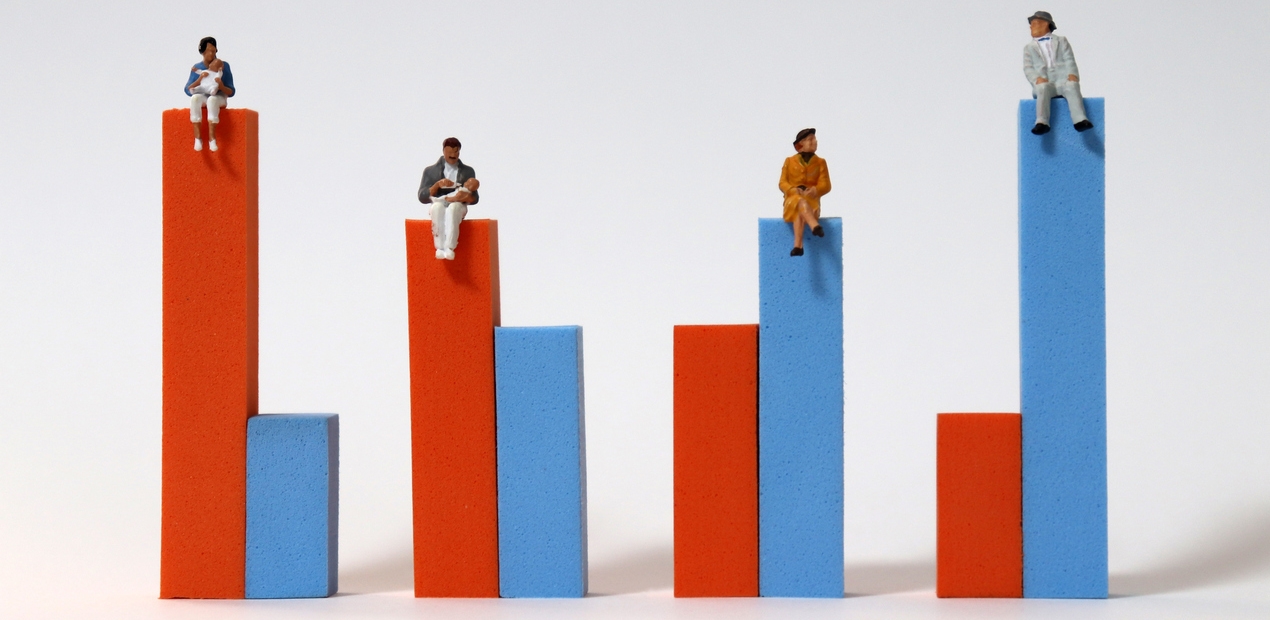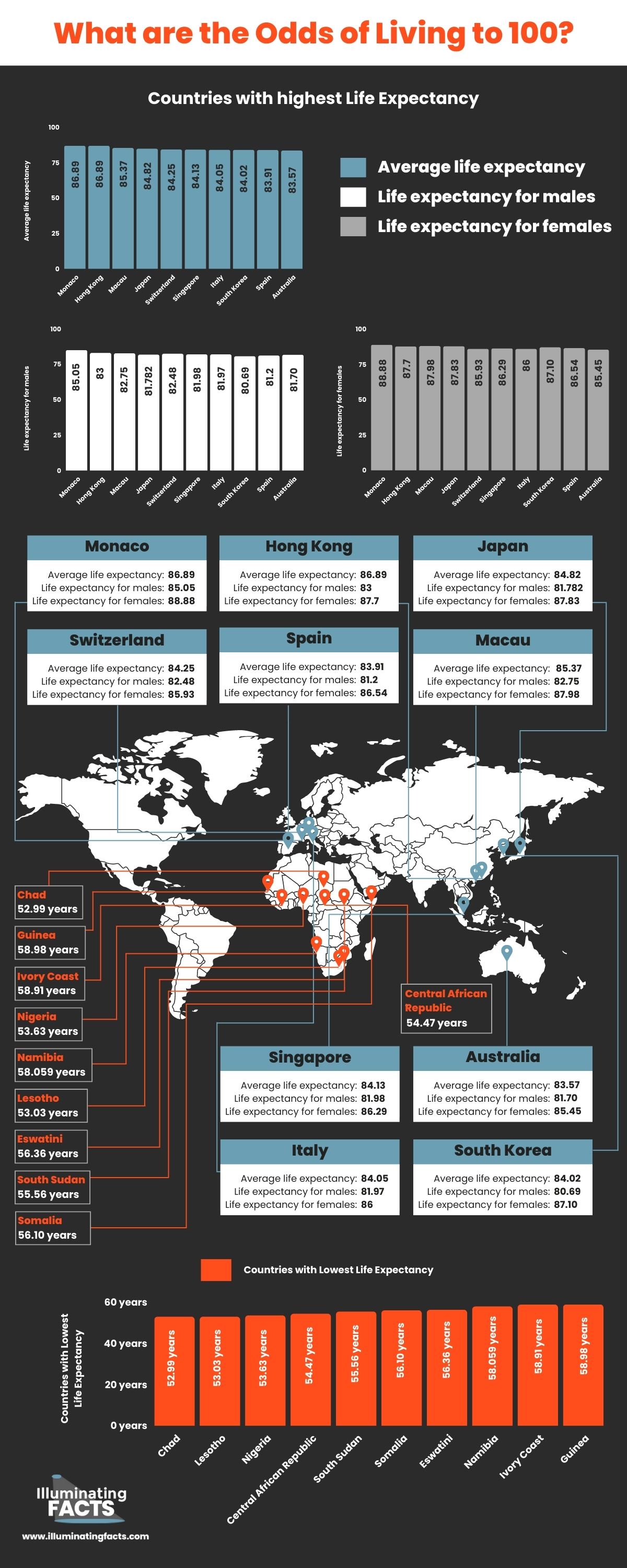The answer to what are the odds of living to 100 is a bit complicated. It depends on many factors with where you live being one of the most important. Not all regions have the same life expectancy, which refers to the average number of years people live in a specific region. Developed countries with a good healthcare system, healthy diet and active lifestyle have more life expectancy, while under-developed nations don’t usually have the infrastructure and medical facilities that lead to a higher life expectancy.
A Report on Centurions by the U.S. Census says there were only 53,364 centenarians in 2010, which translates into 1.73 centurions per 10,000 individuals [1]. The US falls behind countries when it comes to life expectancy and reaching to 100, including Japan, which is home to 3.43 centenarians per 10,000 individuals. The most important factors that help determine whether you’ll reach 100 or not include the following.
The Younger the Better
Your odds of living to 100 are tied up with your current age. The younger you are today; the greater is the probability of living to 100 [1]. Those who are already over 50 are less likely to become centenarians than newborns, thanks to constant advancements in the field of medical sciences and improvements in lifestyles. According to estimates by the UK’s Office of National Statistics, the odds of living to 100 are one in three newborn babies (33.33% probability) [2]. What was considered to be a rarity just a few decades ago might become something common in the future.
Just a few decades back, smoking was considered a harmless activity. But science has proven otherwise and the current generation knows very well how dangerous it is for our health. The number of people who live to 100 is expected to rise in the future as more advancements are made in medical sciences, raising average life expectancy. Similarly, with more vaccination and people getting immunized against newer diseases, the chances of reaching 100 increase even more with the passage of time.
Men vs. Women
Women are more likely to live to 100 than men, which is estimated to be around three years more on average [3]. This can be attributed to a number of factors including men tend to take more risks, smoke or consume other harmful substances like alcohol. People have known about this for a long time, but only recently we are getting closer to finding the reasons, including genetics which can alter the way cells age.
The difference was bigger in the old times when men had to take up physically stressful jobs such as mining and farming. But the gap has reduced significantly now since both men and women do similar sedentary jobs. Although the life expectancy numbers have improved a lot of time, the gap between life expectancy of men and women has remained almost constant. The gap is a lot wider in some countries like Russia where women are likely to live for 13 years more than men, which is generally attributed to men smoking and drinking heavily.
Past vs. the Future
The average life expectancy of a newborn girl in 1841 was 42.2 years and 40.2 for newborn boys [4]. We have come a long way since then in terms of how long we can live. In 2011, life expectancy of a newborn doubled to 82.8 and 79 respectively.
A much higher number of infant deaths was one of the main reasons for such low life expectancy in the 19th century. For reference, about 15 percent of newborns died in their first year in the 1840s, which in 2011 was 0.4 percent. Things are expected to keep improving in the future because of better medical facilities, childhood immunizations, improved hygiene and more accessible medical services.
Health and Life Expectancy
Good health generally means longer life expectancy, but there are many factors associated with being in good shape with diet being one of the most important. The concept is referred to as healthy life expectancy, which can vary greatly between different parts of the world and even the same country. Japan and South Korea are among the countries with the highest life expectancy, thanks to their balanced diet that includes seafood and an active lifestyle.
Healthy life expectancy combines both the length and quality of life and is becoming the new standard for measuring the overall health of the population. The metric helps measure the impact of health policies, highlight health inequalities and plan for fiscal and social policies in a better way.
The Best and the Worst
In addition to factors such as genetics, gender, diet, hygiene, access to healthcare, lifestyle, culture, exercise and crime rates, where you live also plays an important role in determining life expectancy. Genetics and lifestyle are the two most important factors and vary from one region to another. With 72 years (69.8 for males and 74.2 for females) being the global life expectancies [5], the following are the top 10 countries where people are more likely to reach 100 [6].
1. Monaco
Average life expectancy: 86.89
Life expectancy for males: 85.05
Life expectancy for females: 88.88
Reasons: One of the wealthiest principalities, seafood, state-funded healthcare
2. Hong Kong
Average life expectancy: 86.89
Life expectancy for males: 83
Life expectancy for females: 87.7
Reasons: Rapid economic development, world’s lowest infant mortality rate, high quality healthcare
3. Macau
Average life expectancy: 85.37
Life expectancy for males: 82.75
Life expectancy for females: 87.98
Reasons: strong economy, solid healthcare system, clean air and healthy environment
4. Japan
Average life expectancy: 84.82
Life expectancy for males: 81.782
Life expectancy for females: 87.83
Reasons: mainly attributed to diet that includes fresh meat, fruits and vegetables, universal health insurance, active lifestyle
5. Switzerland
Average life expectancy: 84.25
Life expectancy for males: 82.48
Life expectancy for females: 85.93
Reasons: diet, economy and use of natural dairy products
6. Singapore
Average life expectancy: 84.13
Life expectancy for males: 81.98
Life expectancy for females: 86.29
Reasons: low infant and traffic mortality rates, lowest mortality rates due to pollution, contaminated water, cardiovascular and respiratory diseases
7. Italy
Average life expectancy: 84.05
Life expectancy for males: 81.97
Life expectancy for females: 86
Reasons: Mediterranean diet, strong family bonding, active lifestyle
8. South Korea
Average life expectancy: 84.02
Life expectancy for males: 80.69
Life expectancy for females: 87.10
Reasons: very low rate of cardiovascular diseases and other lethal illnesses including cancer and TB, National Health Insurance that includes all private insurance companies
9. Spain
Average life expectancy: 83.91
Life expectancy for males: 81.2
Life expectancy for females: 86.54
Reasons: balanced diet, excellent healthcare system, socially active lifestyle
10. Australia
Average life expectancy: 83.57
Life expectancy for males: 81.70
Life expectancy for females: 85.45
Reasons: low disease-related and infant mortality rates, advanced medical treatments, high vaccination rate
Countries with Lowest Life Expectancy
Most of the countries with the lowest life expectancy rates happen to be in Africa, which shows how wide the gap is between rich and poor countries. Malnutrition, epidemics such as the AIDS epidemic, civil strife and lack of resources to deal even with curable diseases are some of the main reasons for such a gap. Afghanistan is the only country out of Africa where life expectancy is close to or less than 50 years.
Africa faces a severe shortage of doctors and nurses, but there are signs of hope as life expectancy has been on the rise since the early 2000s, thanks to healthcare improvements and treatment for previously incurable diseases such as AIDS. Following are the countries with lowest total life expectancy in the world [6]:
- Chad 52.99 years
- Lesotho 53.03 years
- Nigeria 53.63 years
- Central African Republic 54.47 years
- South Sudan 55.56 years
- Somalia 56.10 years
- Eswatini 56.36 years
- Namibia 58.059 years
- Ivory Coast 58.91 years
- Guinea 58.98 years
Conclusion
The odds of living to 100 are greater in some countries with women having an edge over men. Over 80 percent of individuals over 100 are women, which sums up how things are going to be in the future. Life expectancy today is the highest and is expected to keep increasing with more advances in medical sciences and easily accessible healthcare.
References
[1] Meyer, J. (2012). Centenarians: 2010. https://usa.ipums.org/. Retrieved September 20, 2022, from https://usa.ipums.org/usa/resources/voliii/pubdocs/2010/2010%20Special%20Reports/c2010sr-03.pdf
[2] Office for National Statistics (2016, January 14). What are your chances of living to 100? ons.gov.uk. Retrieved September 20, 2022, from https://www.ons.gov.uk/peoplepopulationandcommunity/birthsdeathsandmarriages/lifeexpectancies/articles/whatareyourchancesoflivingto100/2016-01-14
[3] Robson, D. (2015, October 2). Why do women live longer than men? https://www.bbc.com/. Retrieved September 20, 2022, from https://www.bbc.com/future/article/20151001-why-women-live-longer-than-men
[4] (2015, September 9). How has life expectancy changed over time? https://www.ons.gov.uk/. Retrieved September 20, 2022, from https://www.ons.gov.uk/peoplepopulationandcommunity/birthsdeathsandmarriages/lifeexpectancies/articles/howhaslifeexpectancychangedovertime/2015-09-09
[5] WHO (2015). GHE: Life expectancy and healthy life expectancy. who.int. Retrieved September 20, 2022, from https://www.who.int/data/gho/data/themes/mortality-and-global-health-estimates/ghe-life-expectancy-and-healthy-life-expectancy
[6] UN (n.d.). GHE: Life expectancy and healthy life expectancy. population.un.org. Retrieved September 20, 2022, from https://population.un.org/wpp/Download/Standard/Mortality/







